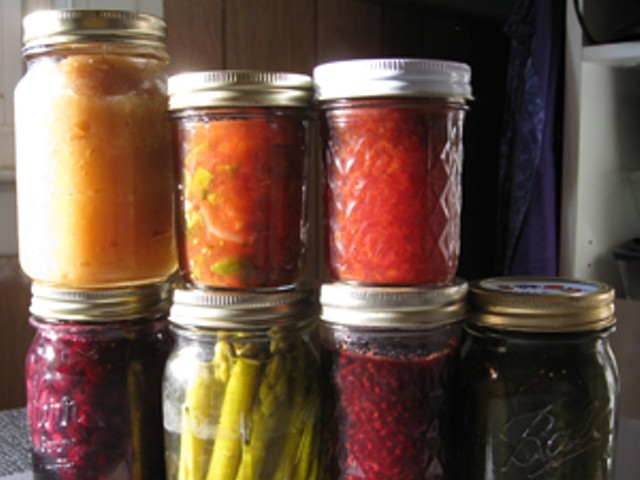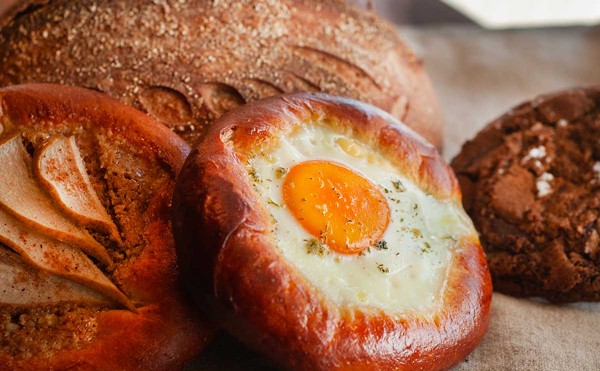It all started with booze. Picture the Neolithic hunter-gatherer coming home from a couple of weeks in the bush to find the honey he had collected before he left a simmering mess. Ravenous from his adventure, he would take a small taste, realize that this strange, not exactly rotten brew wasn't going to kill him — and the next thing you know the edges of his world have softened and after seeing God he carves mad poetic figures into the walls of his cave. Thus begins our love affair with fermentation.
Human beings have benefited from the results of fermentation since before recorded history. Natural and local microorganisms, such as mold, yeast and bacteria, can transform organic matter into all sorts of tasty pleasures that support general good health. What's more, they can be stored for extended periods, and when made at home they cost a fraction of their typically less flavorful store-bought cousins.
Think of home fermentation as the opposite of homogenization. The conversion that occurs on your kitchen counter is unique. Only relatively recently have commercial goals of consistency and quick production above all else turned much of our fermented food (or its substitutes) into hollow shells of the natural and varied things they once were.
It's simple to start fermenting at home. Sometimes you'll need only buy the ingredients; the microorganisms that ferment foods are either all around us — or easily purchased. And once you acquire the taste and appreciate how easy and cheap it is to ferment your favorite foods, there's no going back.
Fermentation of fruit and grains into alcohol for pleasure (and ceremony) dates from the beginning of civilization. And in this region, cider is the easiest way to start fermenting alcohol. What's more, cider can go through even another stage of fermentation — with the help of oxygen, acetic acid bacteria will convert alcohol into vinegar.
Take Oak Park resident Kim Adams. She has been turning wine into vinegar for nearly two decades. Working in the wine field, she hated to see surplus wine from trade tastings poured down the drain. After reading an article about vinegar-making in a local paper, Adams promptly found a source for mother of vinegar at a hardware store on Detroit's east side.
It takes roughly three months to complete a batch of vinegar, and Adams keeps several crocks going at a time, from dessert-type vinegar made from fruit wines to her standard red wine vinegar made from the dregs of unfinished bottles. Reproductions of that first mother have been shipped as far as France. She lost her job in January due to the economy and has been seriously considering a jump to producing vinegar commercially using Michigan wine as a base.
An ancient ferment of sweetened tea by a kombucha "mushroom" creates a fizzy beverage with some similarity to vinegar but much milder in flavor and ready in weeks. Looking something like a ghostly ham steak, the "mushroom" is actually a Symbiotic Culture Of Bacteria and Yeast — SCOBY for short. Though the Internet is rife with fantastical fitness claims, it's enough that a properly brewed kombucha drink is healthy, tart and tasty, especially when allowed to carbonate with the sugar from your favorite fruit juice. Like vinegar, a mother of kombucha is easily split and shared, and it's common to find communities where a single culture has spawned dozens of "babies."
Vegetables are also easy home ferments. Requiring nothing but a simple saltwater brine to prevent unwanted microbial growth, vegetables come with their own fermenting microorganisms. Lactic acid bacteria that convert vegetable sugars into acid give home fermented pickles their characteristic sourness, tarter than the flavor of distilled vinegar typically found in store-bought pickles.
A large, nonreactive crock made of glass or ceramic can be packed with any vegetables as creatively as you like: cucumbers, carrots, turnips, cabbage, radishes, etc. Cucumbers with dill and spices make what we largely consider classic pickles. Shredded cabbage alone or with apples and carrots will eventually turn into sauerkraut. You can even add seafood and red chili for Korean-style kimchi.
These are just a few variations for the home kitchen. Among other popular ferments are sourdough, yogurt, kefir, cheese and soy ferments — in many cases preferred over commercial versions.
In ancient times, fermentation joined smoking and drying as essential food preservation techniques. Today, besides being an economical means of producing healthy and uniquely flavored food, home fermenting is a way to reach out across time for a connection to our ancestors.
There's nothing on a grocery market shelf that can make that claim.
Detroit Evolution Laboratory will be offering several courses this summer including a fermenting and pickling class sometime in early August and a kombucha workshop in September, with students going home with their own starter SCOBY. There is also the possibility of a fermented drinks class, touching on rejuvelac, kombucha, kefir and ginger beer in July. Learn more at detroitevolution.com or by calling 313-316-1411.
Read more about making vinegar on Kim Adams’ website: http://www.gangofpour.com/diversions/vinegar.
Pickle and sauerkraut recipes can be found at Wild Fermentation: wildfermentation.com





